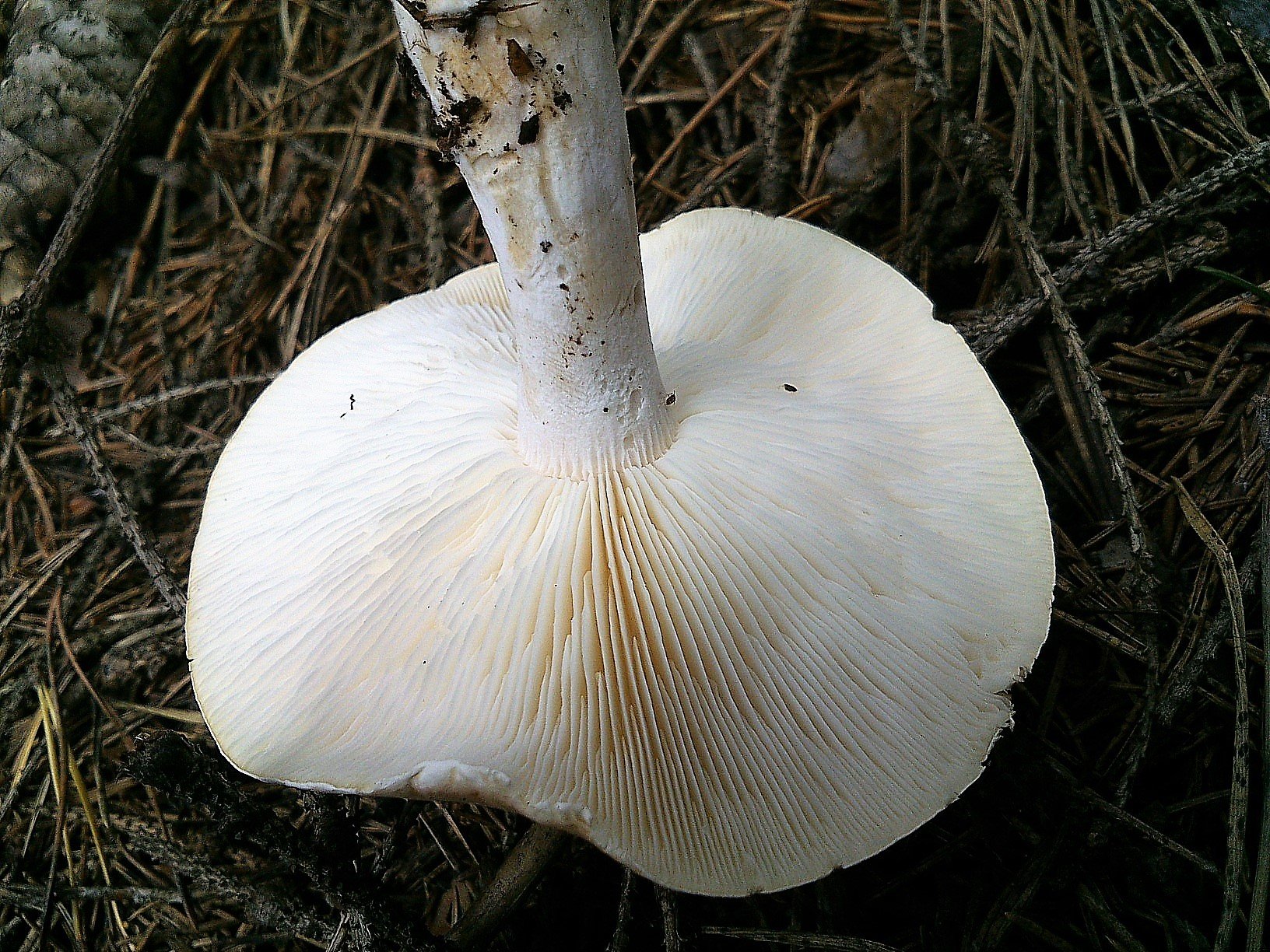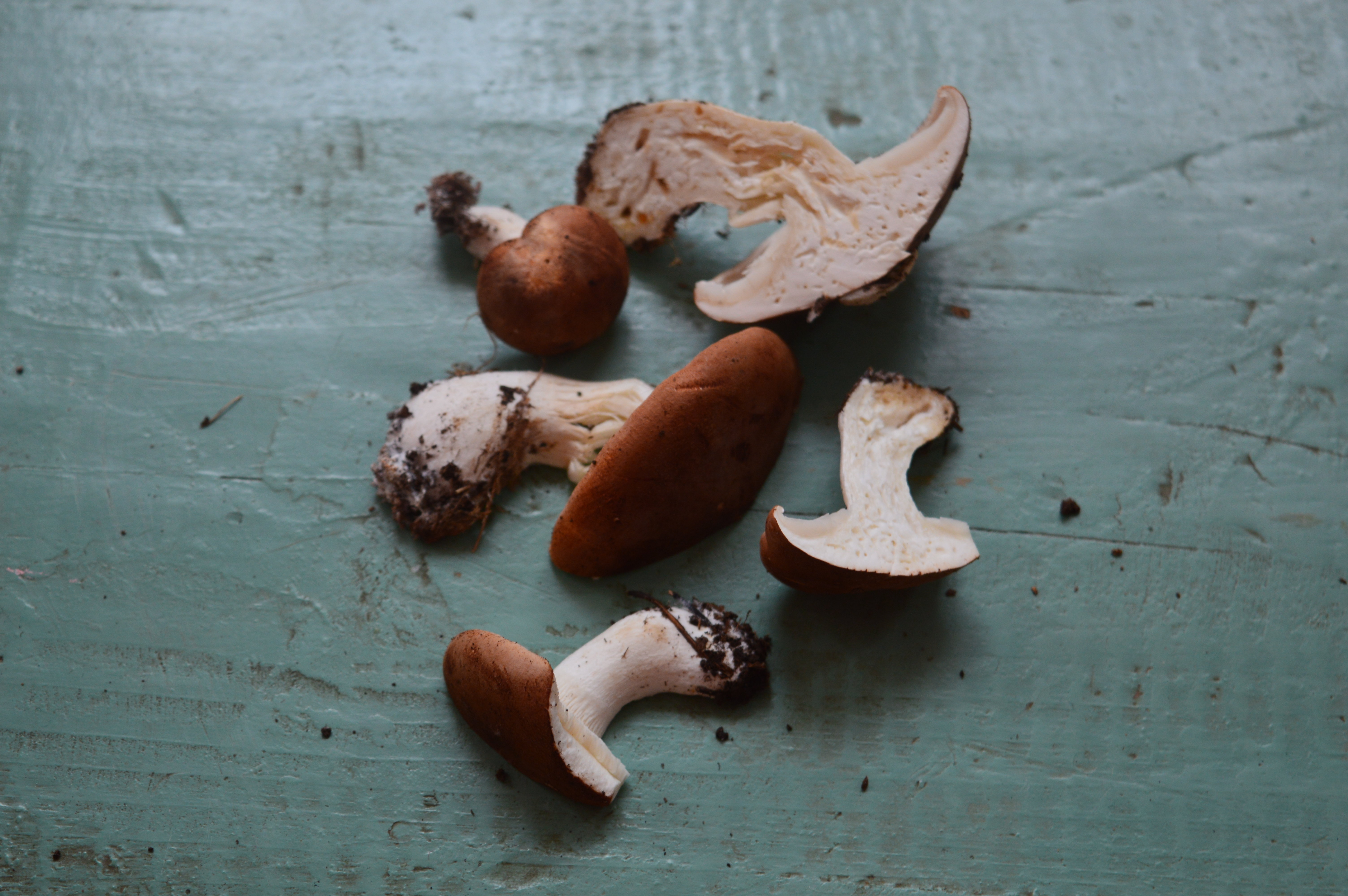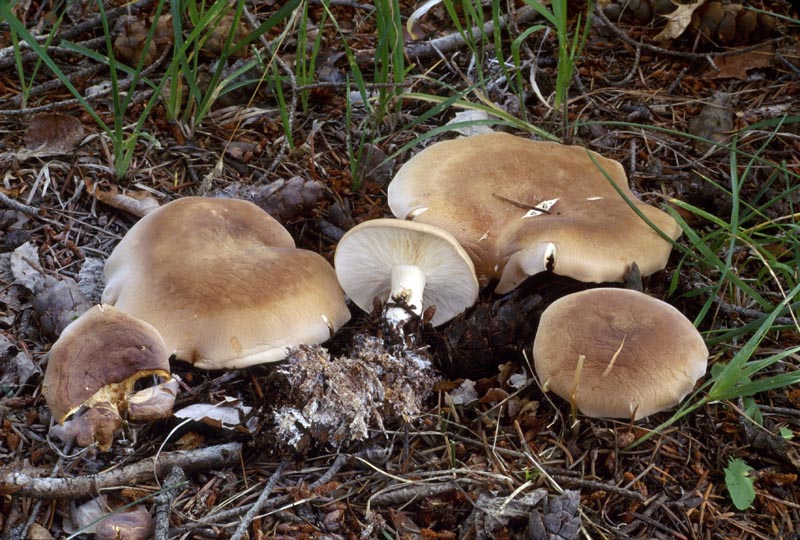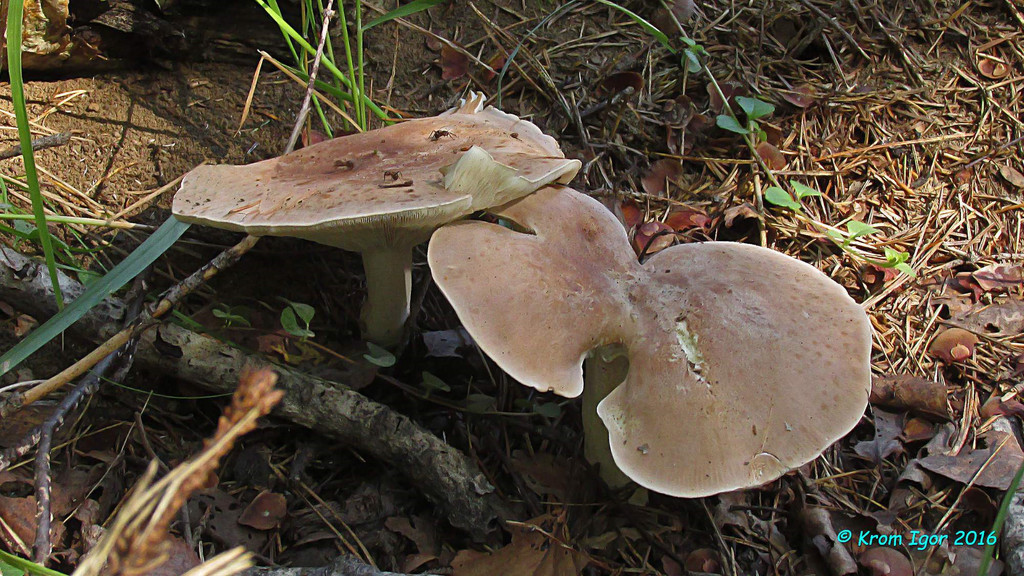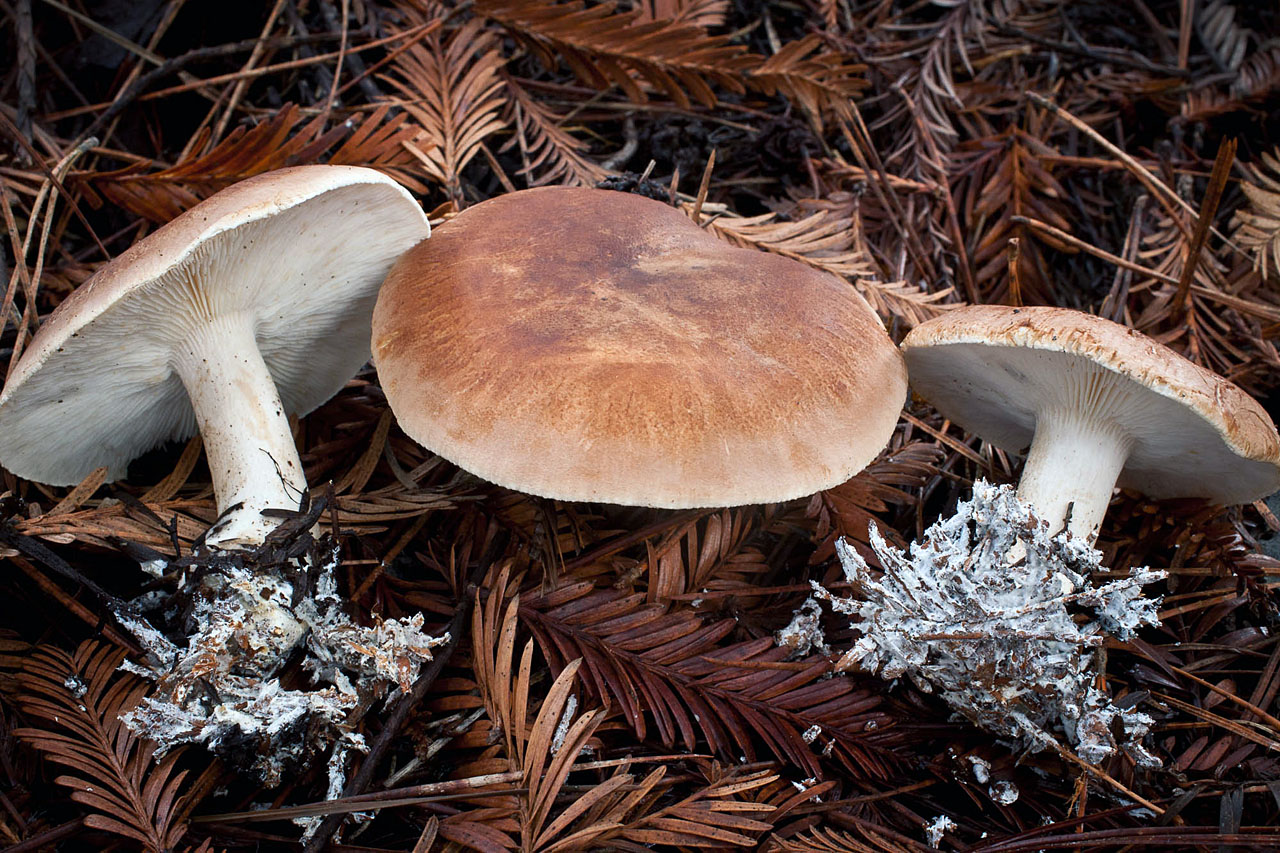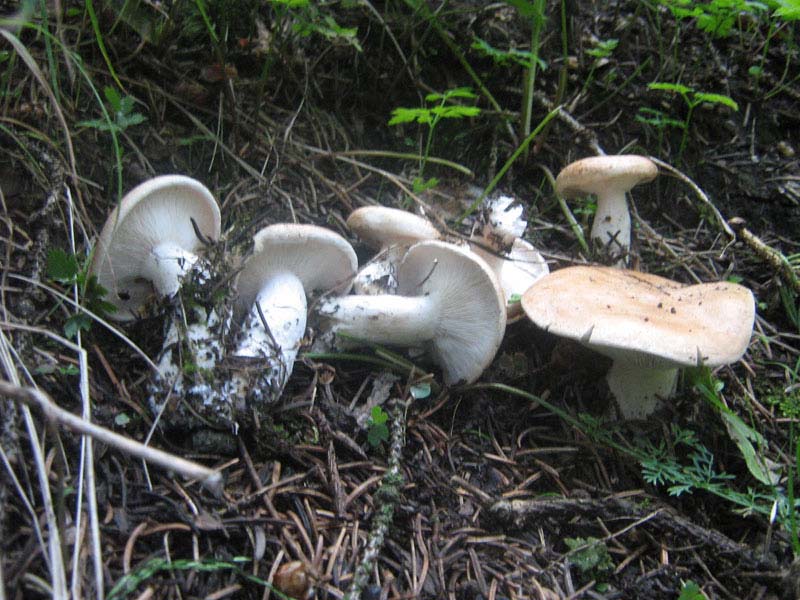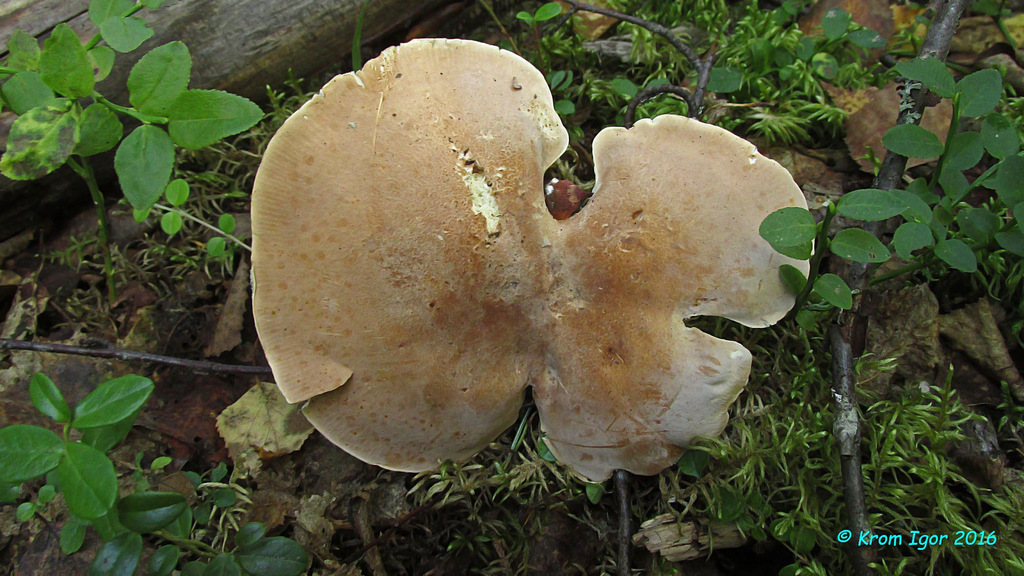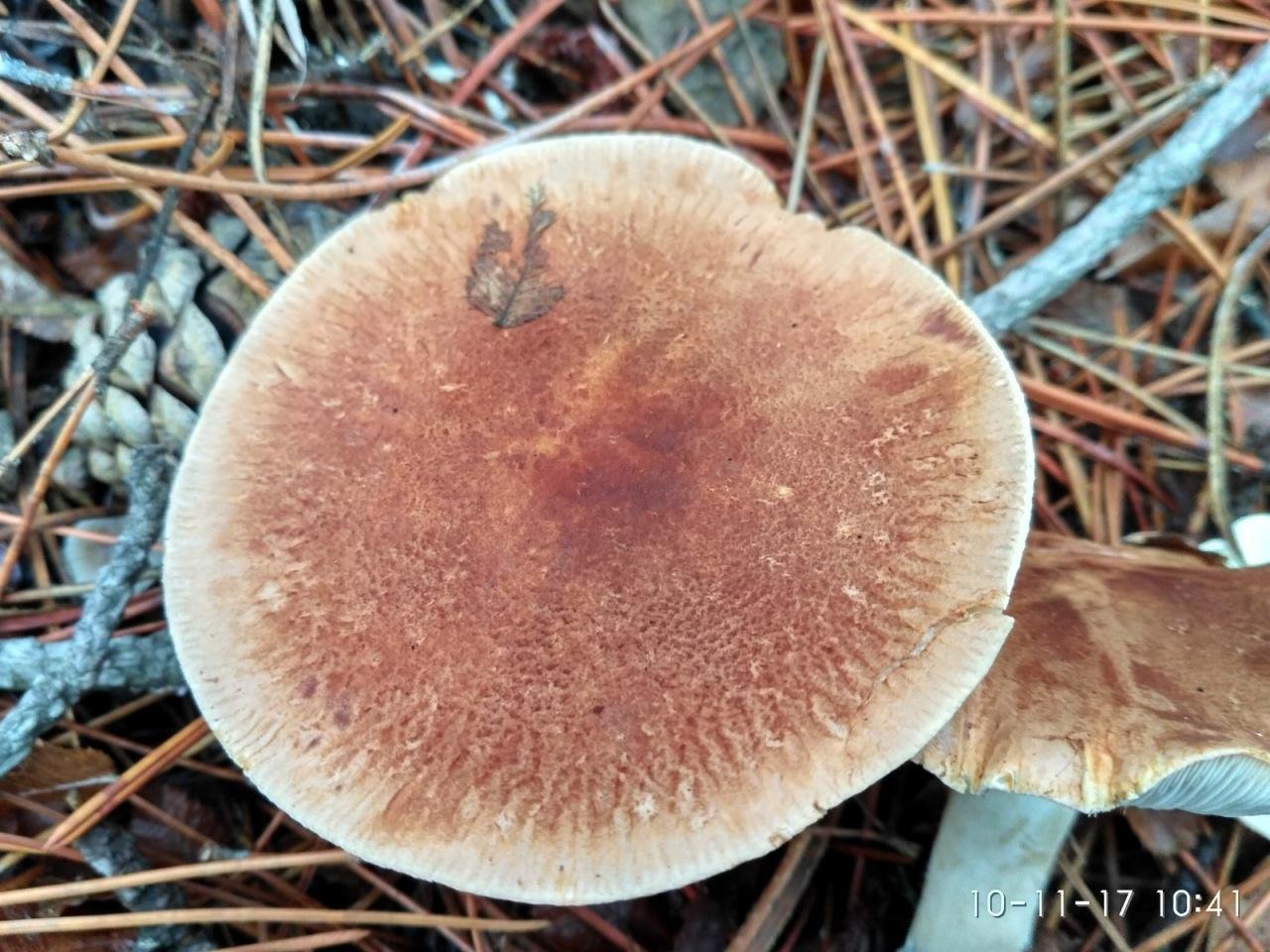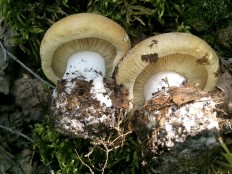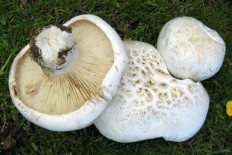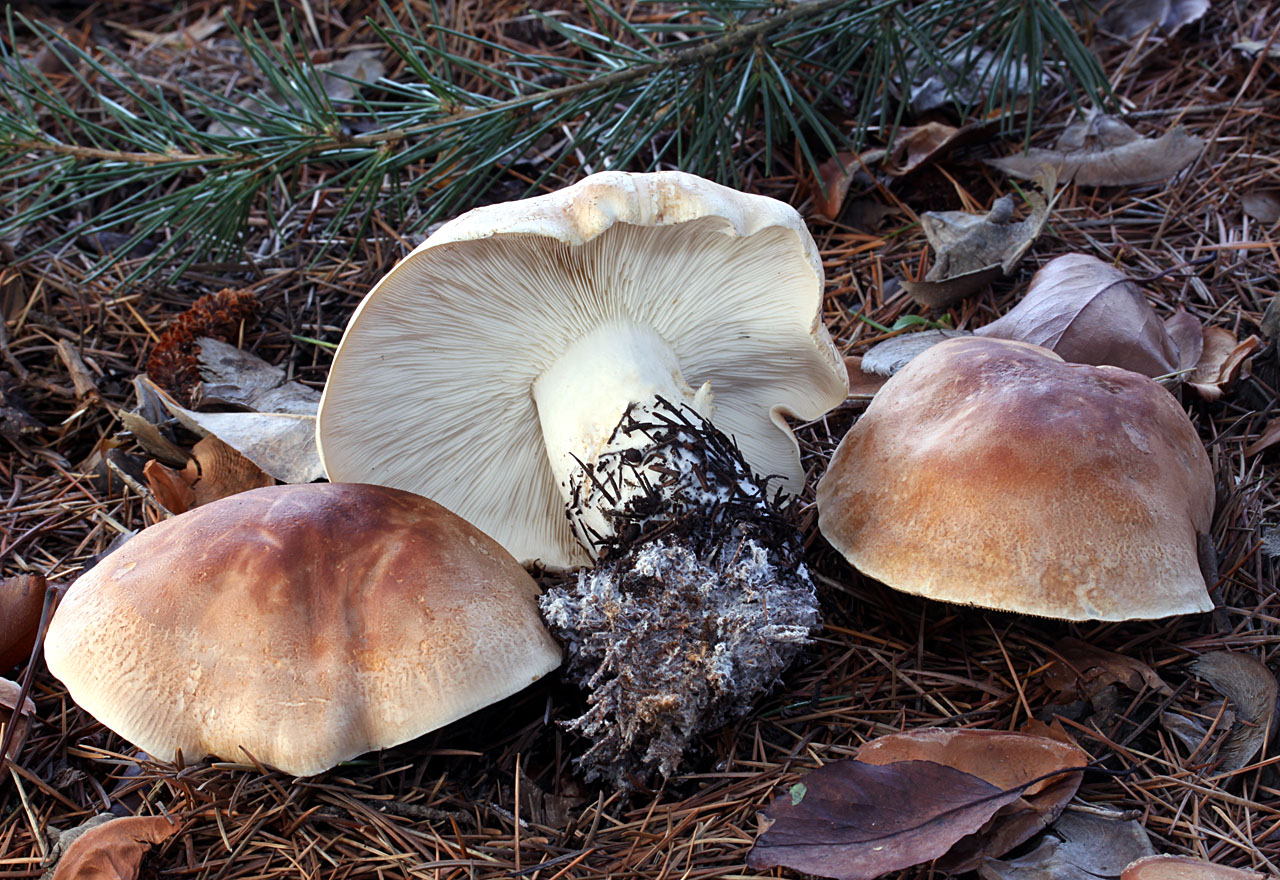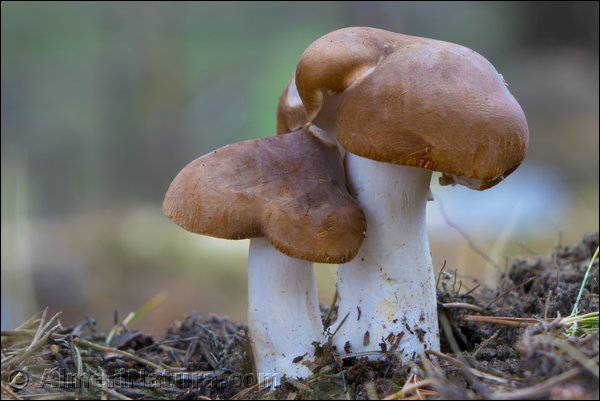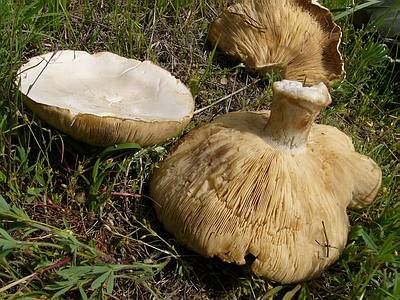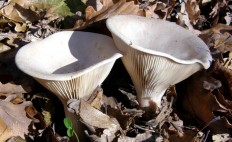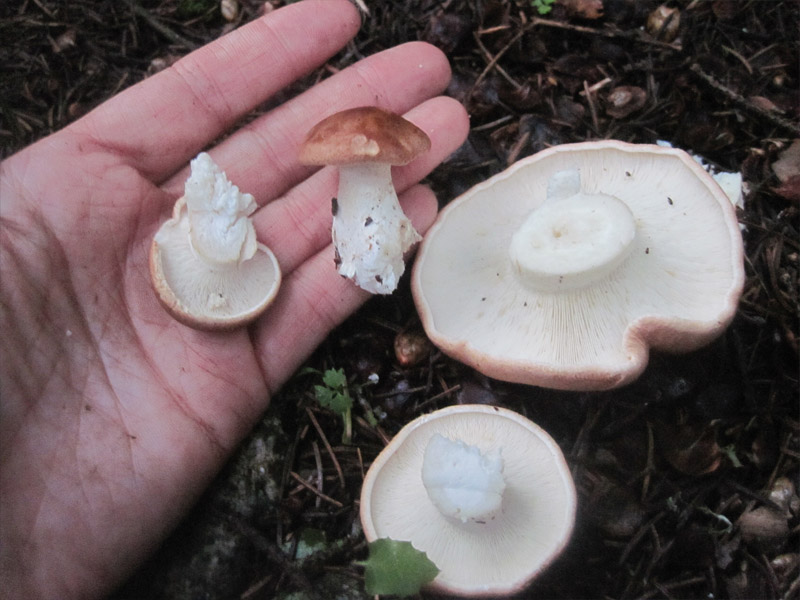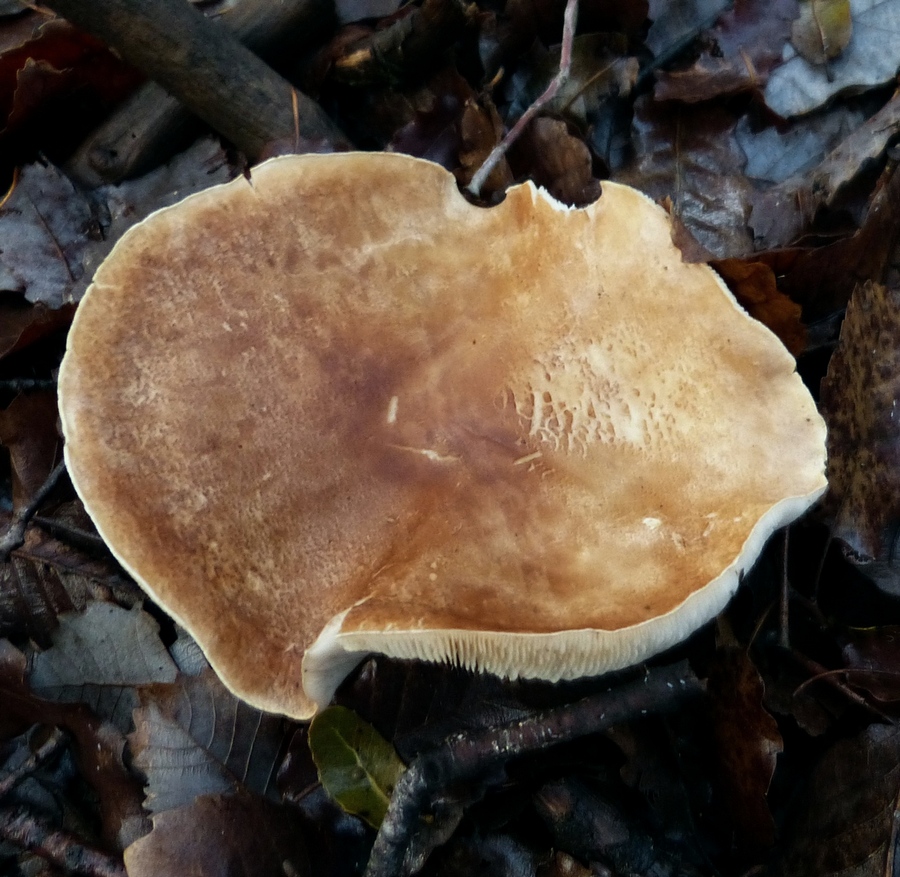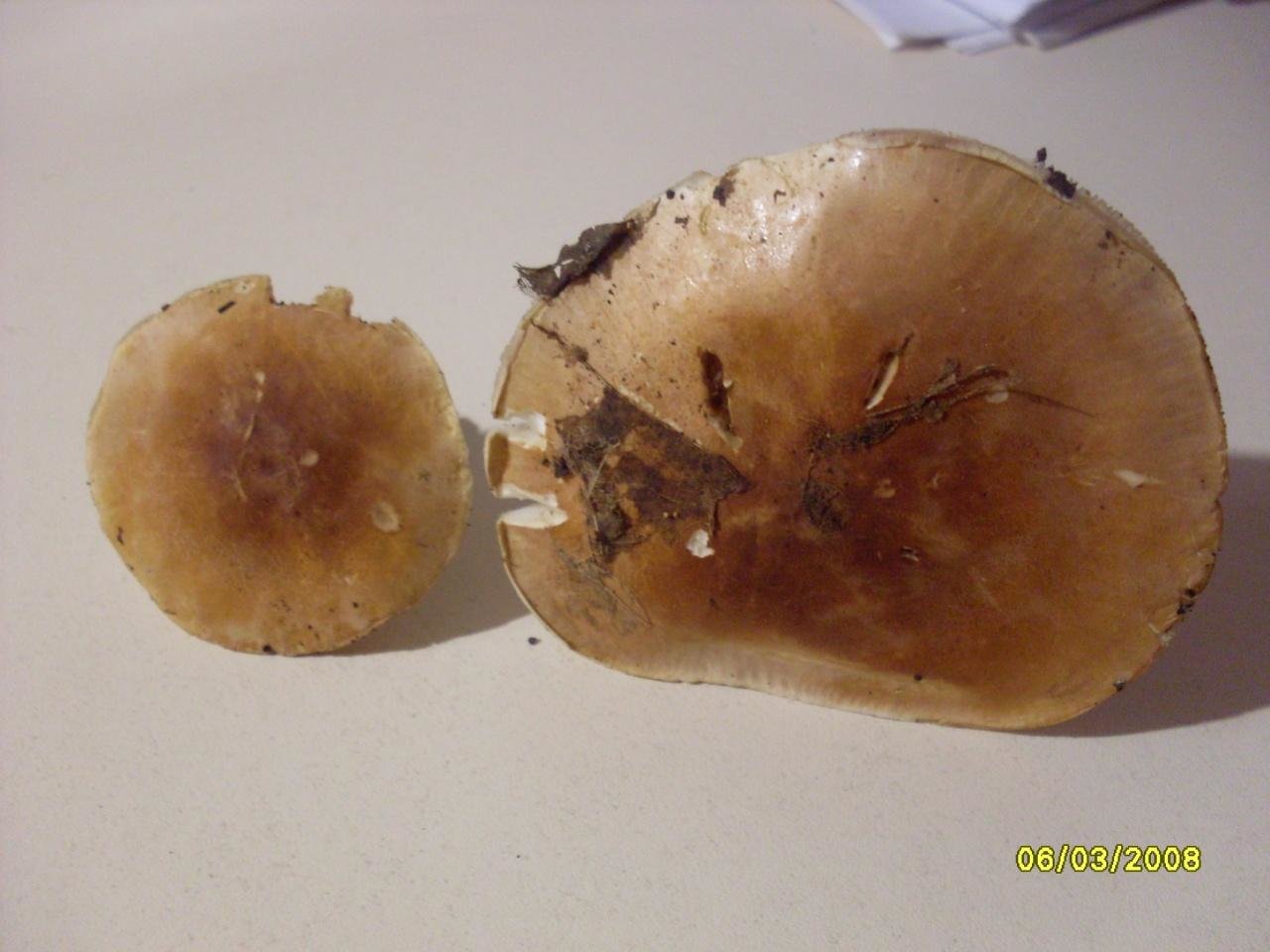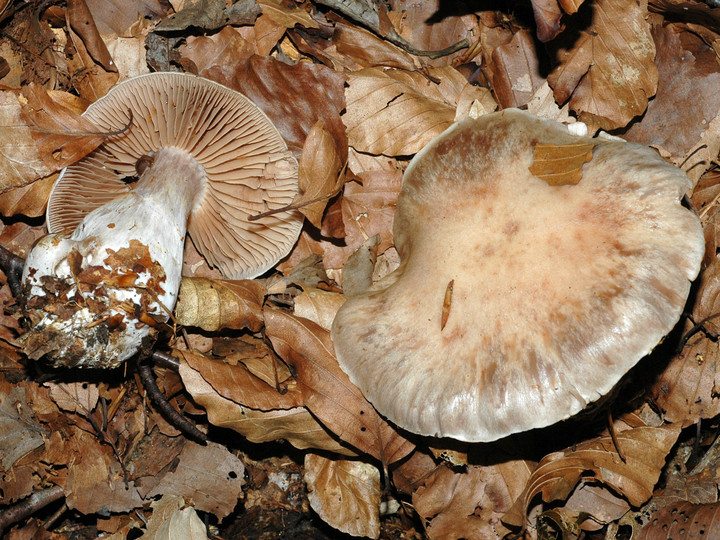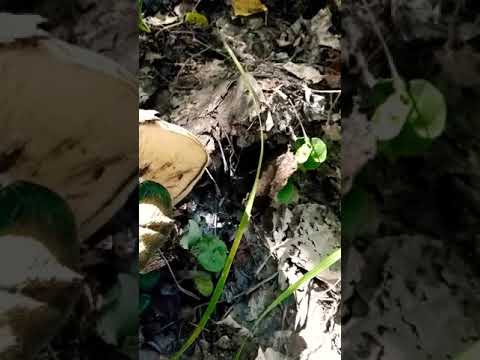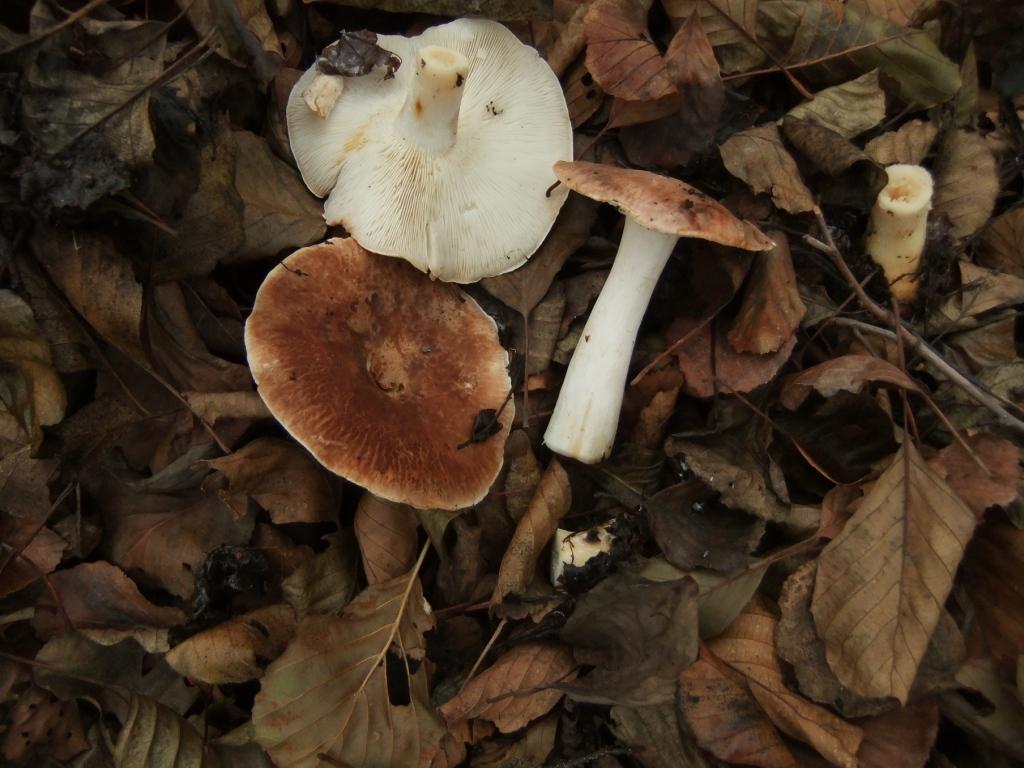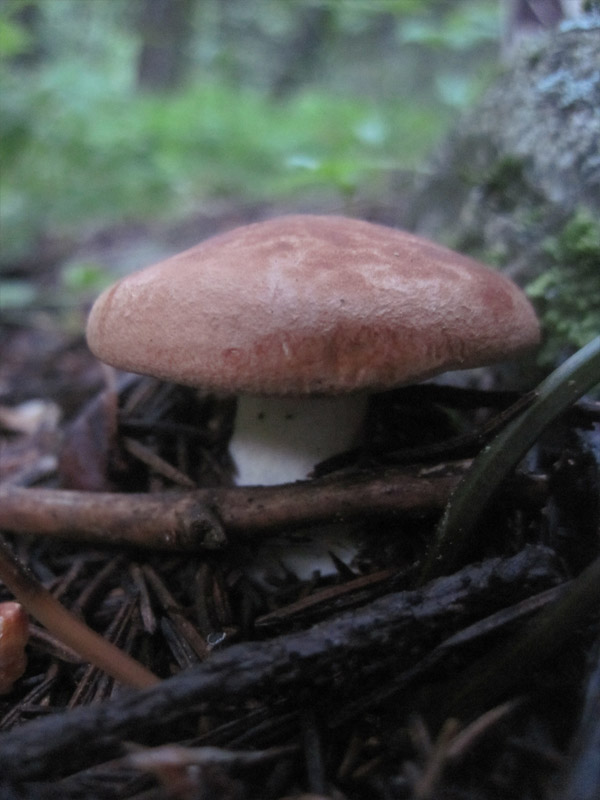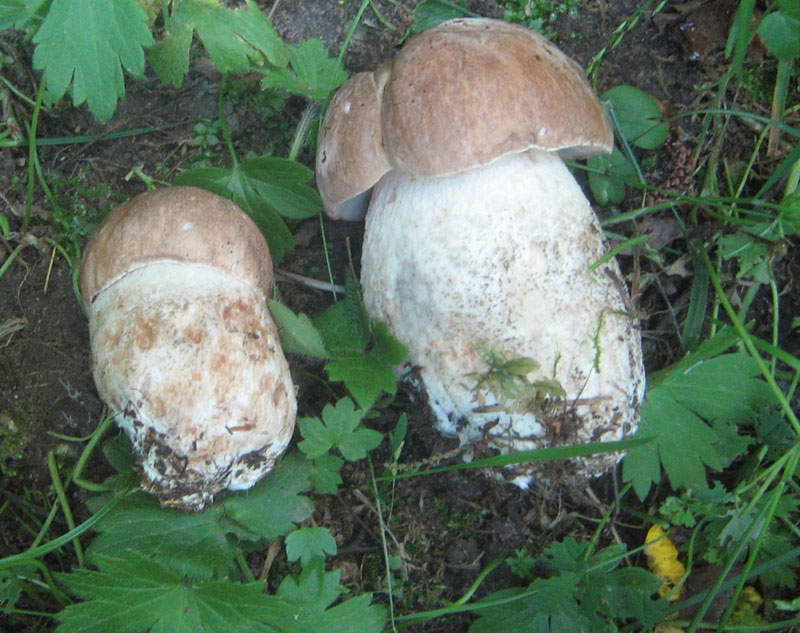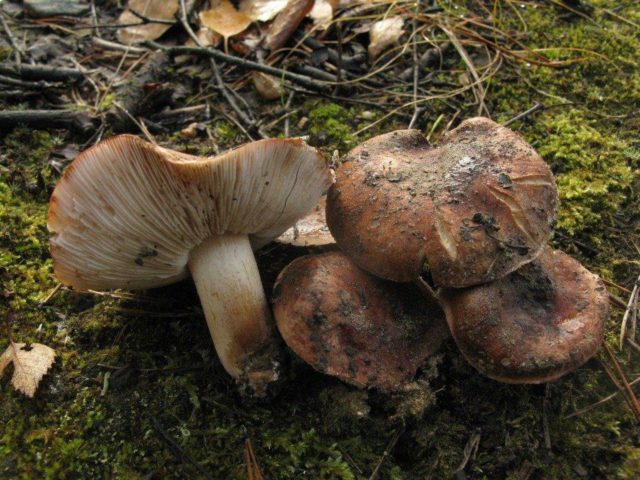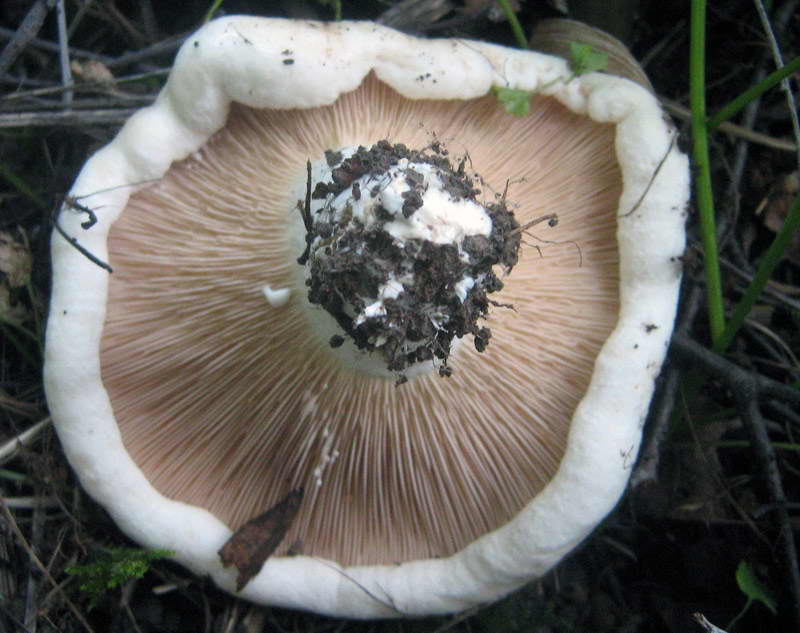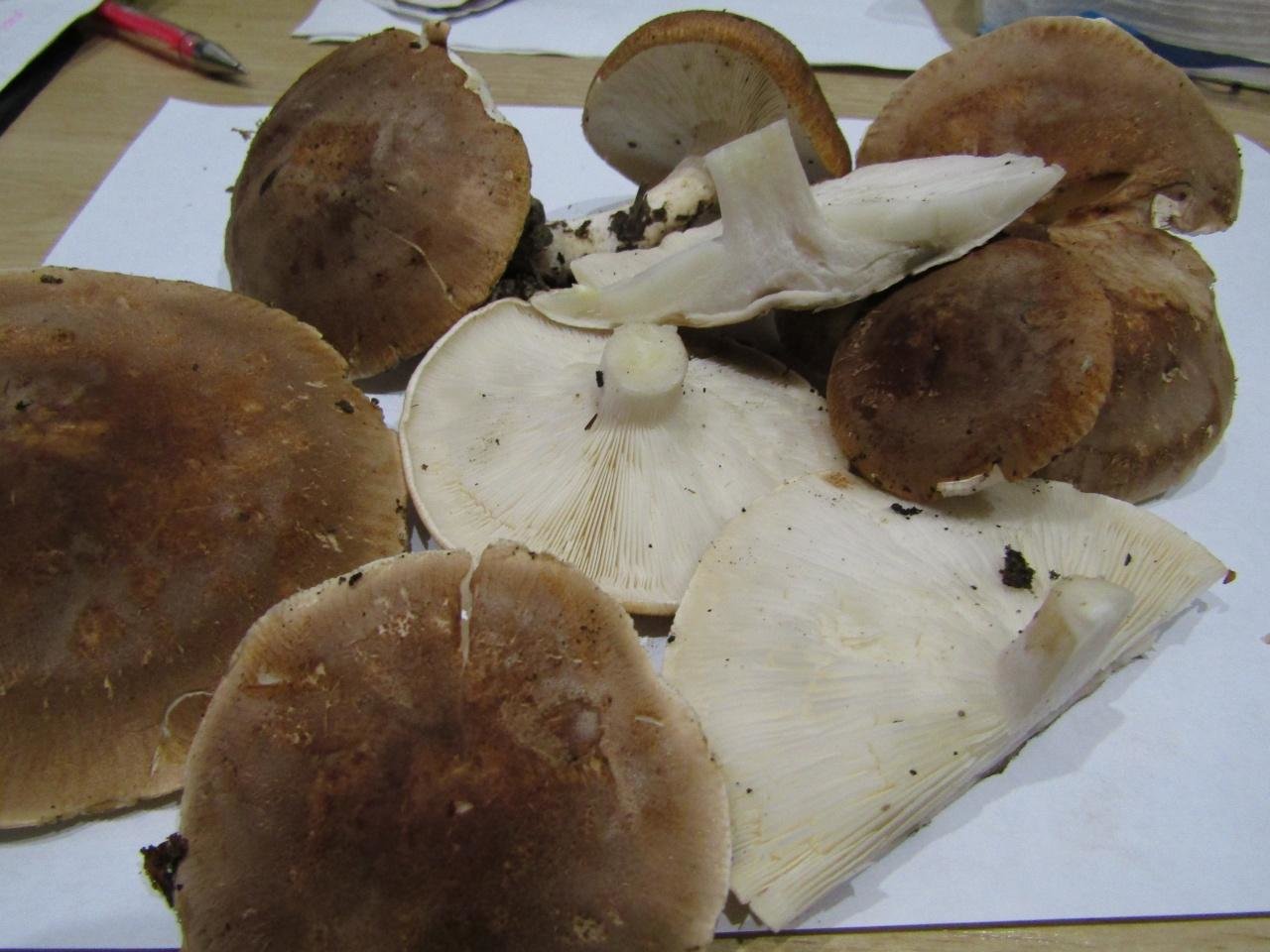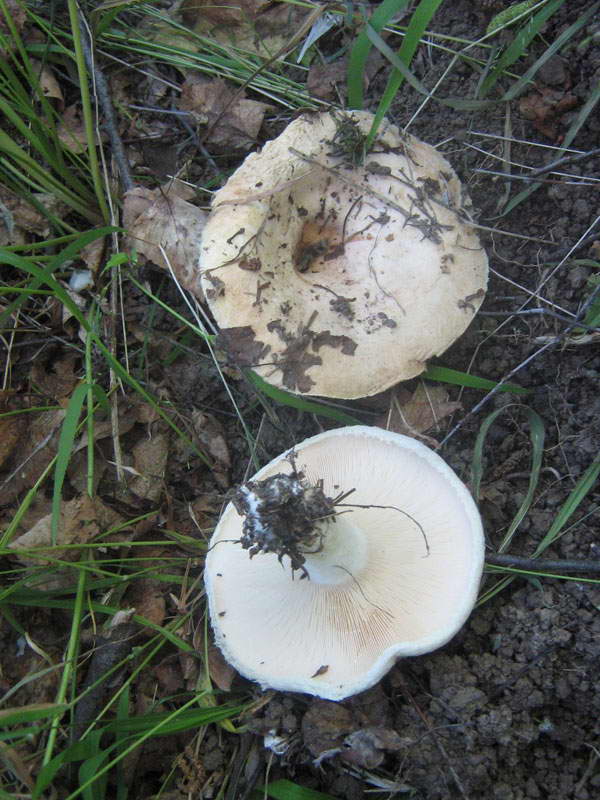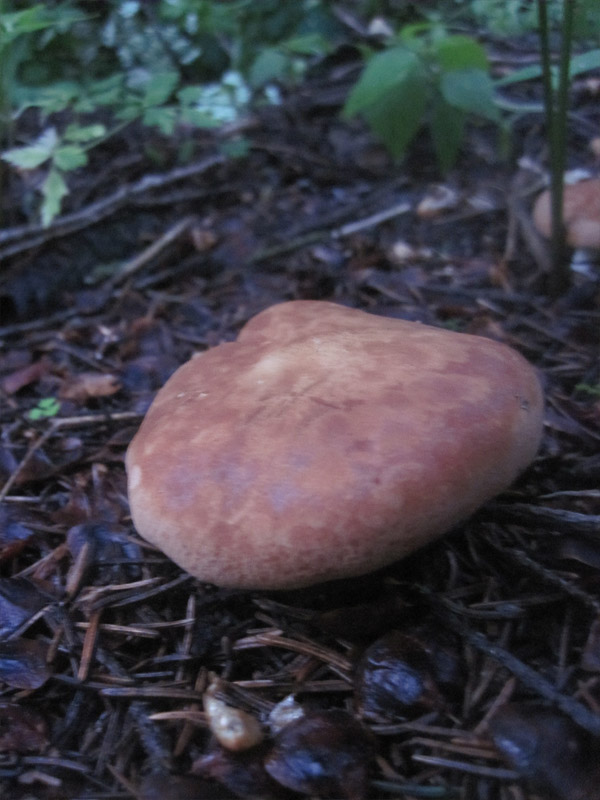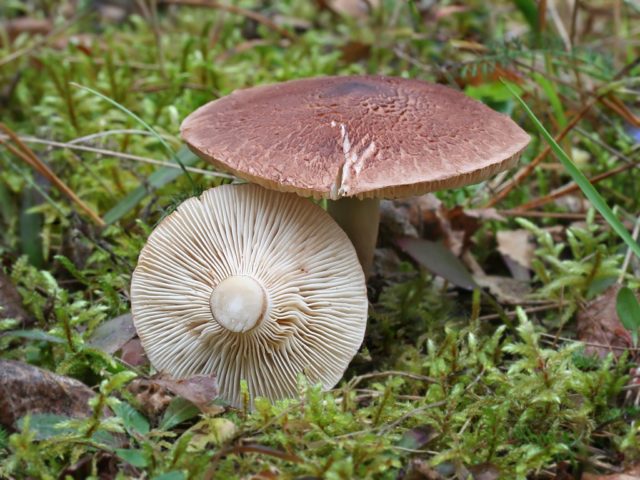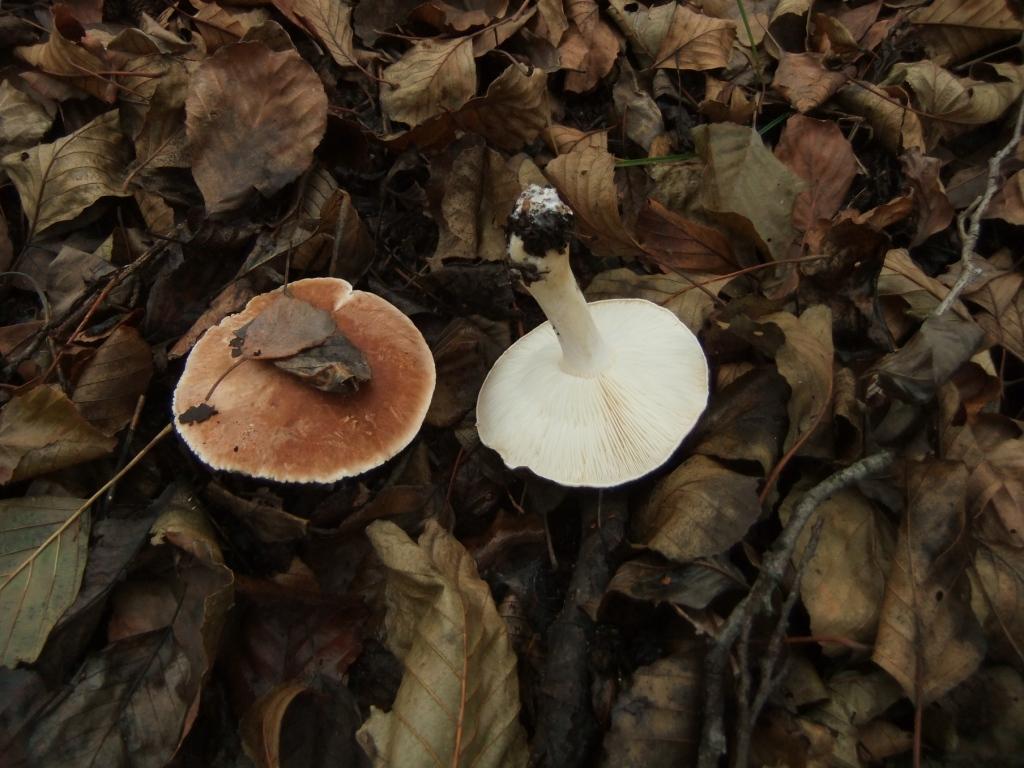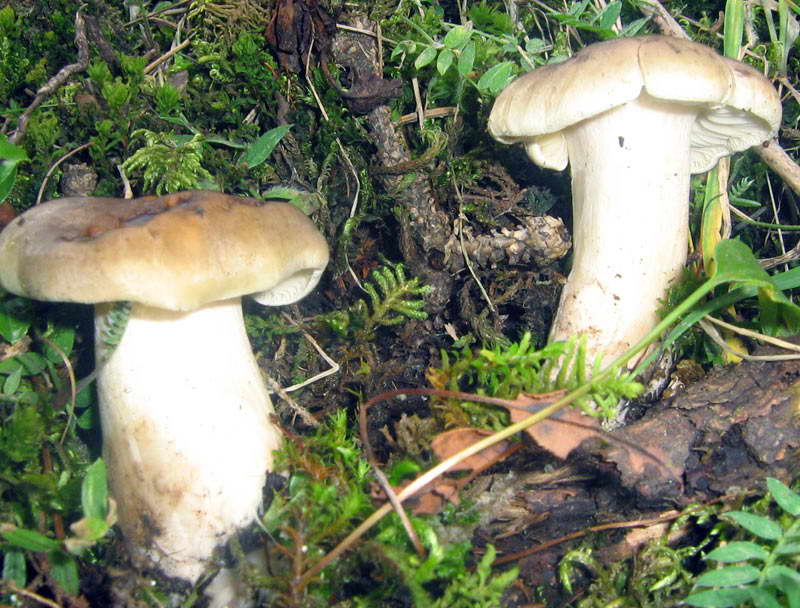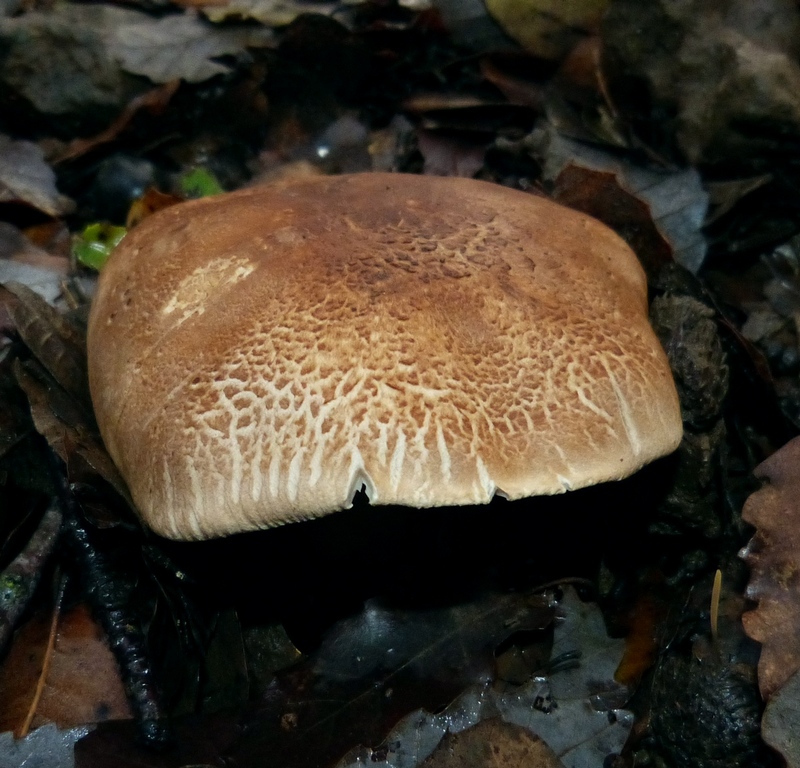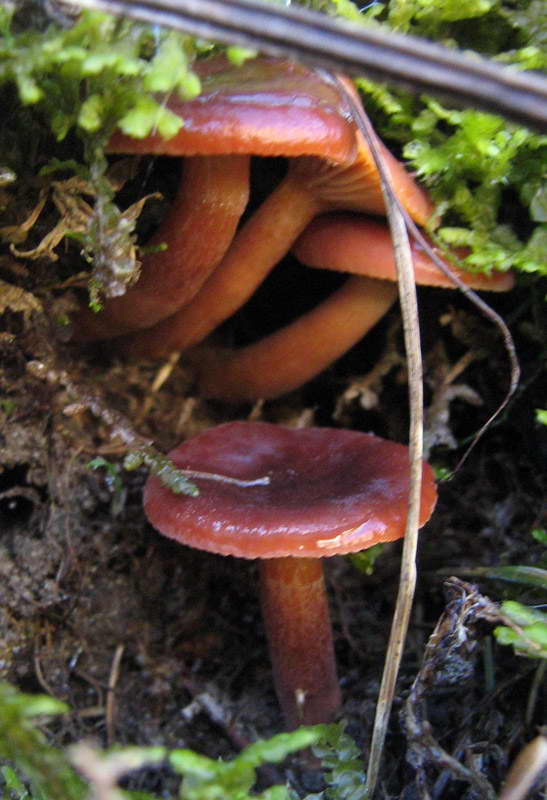White pig gentian: where it grows, what it looks like, is it possible to eat
| Advanced Search |
Not registered? Click here to register.
Forgot your password? Request a new one here.
· Total users: 6,982 · New user: Maleccc
White pig bitter
Insert-tree-fungus Synonyms Agaricus amarus (Alb. & Schwein.) Fr., 1821 Agaricus rivulosus var. amarus Alb. & Schwein., 1805 Clitocybe amara (Alb. & Schwein.) P. Kumm., 1871 Clitocybe phyllophila var. amara (Alb. & Schwein.) Raith. Lepista amara (Alb. & Schwein.) Maire, 1930 Omphalia amara (Alb. & Schwein.) Quél., 1886 Tricholoma amarum (Alb. & Schwein.) Rea, 1922
Etymology: Leucopaxillus (Greek leukos - white; paxillus - a genus of mushrooms) amarus / gentianeus (Latin amarus - bitter / Latin gentiana - gentian - a genus of herbs that have a very bitter taste of roots and leaves).
Hat: 4-12 (20) cm in diameter, first hemispherical, then convex or flat-convex, sometimes flat-spread with a slight depression in the center, reddish-brown, darker in the middle, gradually fades to orange-yellow or completely white , sometimes cracks appear, the edges are curled.
The plates are weakly descending, narrow, frequent, white, then fawn, white or cream with yellowish, sometimes with reddish-brown stripes or spots, shiny.
Leg: 2-4.5 x 0.8-1.2 cm, ditch, sometimes thickened at the base, dense, white or pale, with white flakes on the surface.
Flesh: white or yellowish-white, with an unpleasant, pungent, mealy odor and an exceptionally bitter taste.
Spores: 4-6 x 3.5-5 microns, almost round, broad-ovoid, colorless, with a drop of oil, amyloid.
Spore powder: white.
Edible is considered inedible due to its bitter taste (non-toxic) and strong chalk odor. According to the authors, the mushroom is edible after prolonged soaking in salted and pickled form and tastes quite good.
Habitat: grows singly or more often in large groups, in open areas and on the litter in old spruce forests, sometimes forming “witch's circles”.
Season: late June - early September, depending on the altitude.
Distribution in Kazakhstan: occurs only in Almaty region, almost everywhere in the places where the Tyanshansk spruce grows.
Habitat: European part of the former USSR, Caucasus, Great Britain, Denmark, Austria, Germany, France, Czech Republic.
From the Authors: When young, the mushrooms are very beautiful, with a dark cap, a white leg and plates, they just ask for a mushroom picker basket. And they can spoil the dining table for an inexperienced mushroom picker, one copy in a saucepan is enough for the rest of the mushrooms to become saturated with bitterness. As the saying goes, a fly in the ointment. So be careful.
* About the Nightmarkin mushroom. Among the Almaty mushroom pickers there was one photographer, a pretty good one, by the name of Shushmarkin. But he himself called himself nothing but Nightmarkin. He was, because now he drank himself to death. And he drank himself down gradually, at first he went for mushrooms in the intervals between drinking bouts, then he began to take a bubble with him. He will drink, sleep under the tree, and it is hard to climb up after the weights with a hangover. And, in order not to return empty, he will pick up this very white pig, soak and salt. And so almost every time. And in the end, in a narrow circle of mushroom pickers, we called this mushroom by his name - the Nightmarkin mushroom.
Salting recipes
Option 1 Gris would be soaked for up to 3 days in cold water, it is better that the water is running, or it must be changed 2-3 times a day. Boil, rinse in cold water (with gradual cooling, the mushrooms darken). Further options are possible. Divide into jars by 2/3, pour with brine, or put in buckets-barrels, sprinkle with spices and salt and put in the cold. Finally, the mushroom is considered ready in 30 days. Option 2 Boil the mushrooms for 20 minutes and soak after boiling. It is much more convenient because boiled mushrooms are heavier than water and do not float to the surface. Care should be taken to keep the water constantly cold. And then everything is the same as in the first version.
White pig gentian
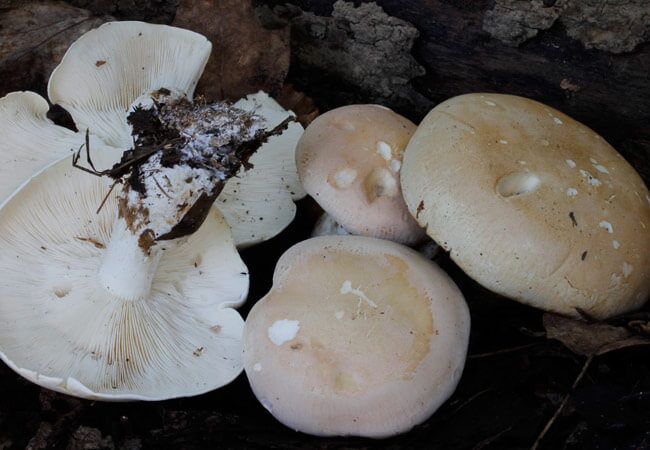
Walking in the summer through the forest, you can come across a fabulous sight - a large family of brownish broad-brimmed mushrooms, forming a circle, the so-called witch's ring. It looks very unusual and beautiful, but the edibility of such a crop raises great doubts.
Indeed, the gentian white pig is unlikely to be able to charm eaters with its overly bitter taste. But still there are lovers of these mushrooms among gourmets.
White pig gentian
White pig gentian - lat. Clitocybegentianea
Earlier in mycology, this type of mushroom was called differently - Leucopaxillusamarus, which means Leukopaxillus bitter or Leukopaxillus gentian.
In the people, you can most often find another, simpler name for this mushroom - the bitter white pig. And it is this that fully justifies its name, because this plant really belongs to the genus Belosvinukha, its taste corresponds to the description.
Mushroom cap
Young bitter white pigs have neat strong caps 3-4 cm with an inward curved edge. Their color is rich brown with different shades from grayish-nutty to brown with reddish.
As they get older, the tip of the mushrooms changes. The hat straightens, becomes open, flatter, and bends slightly downward in old age. On average, its size is 12-15 cm, but sometimes individual mushrooms can grow up to 20 cm in diameter. The color of mature individuals also changes. The pigment seems to fade from the edge. Later, whitish stripes may diverge from the center of the cap.
The surface of the cap is dry, smooth, and its flesh is fleshy. Below there is a lamellar hymenophore, white in young plants, and slightly darkening with age, acquiring a cream color. The plates themselves are adherent, slightly descending along the stem and have different lengths.
Stipe
That in young animals, that in adult mushrooms, the leg is white, straight and dense. Only by adulthood does it become thickened at the bottom and resembles the shape of a club.
The diameter of the leg is on average 1-2 cm, and the height reaches 8 cm. In the context, the flesh does not change color and has a mealy odor.
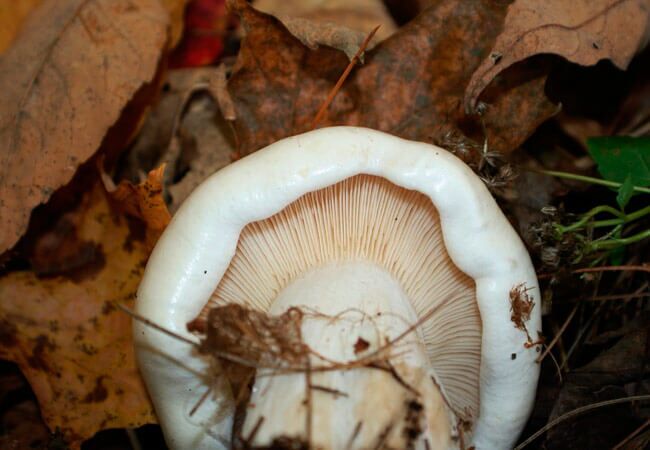
Place of growth
The bitter white pig has chosen conifers as a favorite place. You can also meet it in mixed forests, but only in those parts where spruce and pine trees predominate.
Mushrooms usually grow in large groups in open places on the ground, where there is a solid coniferous litter. Often, a family of white pigs grows in a circle, forming the so-called witch or elf rings. Occasionally you can meet lonely white pigs. They tend to grow under fir trees.
Their habitat stretched across the northern, eastern and middle parts of Europe, the European part of Russia, the Caucasus and North America. These mushrooms are also found in Kazakhstan, mainly in the Almaty region, in the places where the Tien Shan spruce grows.
From the end of June, you can already see the first bitter white pigs. They grow all the rest of summer and the beginning of autumn, until the end of September.
Edibility
The gentian white pig is classified as an inedible mushroom solely due to its taste. It is overly bitter. However, these mushrooms are not poisonous. And in some regions they are even used in preparations for the winter.
To get rid of the bitterness, the mushrooms are soaked for three days, changing the water 3-4 times a day. Then it is boiled and salted with aromatic herbs: dill, horseradish leaves, currant leaves.
Similar species
In appearance white pig is often confused with ryadovki. For example, crowded or scaly rows are very similar to gentian leukopaxillus. In addition, they also grow in conifers and can create "witch rings". However, the ryadovki, unlike the white pigs, have a pleasant mushroom taste, do not taste bitter at all and are readily used in cooking.
Goblet saw-leaf (Neolentinus cyathiformis)
Synonyms:
- Agaricus cyathiformis
- Agaricus schaefferi
- Panus cyathiformis
- Pocillaria cyathiformis
- Neolentinus schaefferi
- Lentinus schaefferi
- Favolus cyathiformis
- Polyporus cyathiformis
- Neolentinus cyathiformis
- Panus urnula
- Lentinus degener
- Lentinus leontopodius
- Panus schurii
- Panus inverse-conicus
- Panus inverseconicus
- Lentinus variabilis
- Pocillaria degeneris
Hat:
Funnel-shaped, up to 25 cm in diameter, reddish-beige, with irregular, rather weakly expressed concentric zones; in old age fades to whitish with a dark spot in the middle.The form is at first hemispherical, with age it opens up to funnel-shaped; the edge is usually uneven. The surface is dry, slightly fleecy.
The flesh of the goblet sawfoil is white, very elastic (you can break the mushroom with only two hands), with an extremely pleasant smell, reminiscent of the smell of fruit.
Plates:
Frequent, narrow, sawtooth-serrated, strongly descending along the stem (almost to the base), in youth white, then cream, darkening to dirty brown.
Spore powder:
White.
Leg:
Short and thick (height 3-8 cm, thickness 1-3 cm), often tapering towards the base, very rigid, almost entirely covered with plates, blackish at the base.
Spreading:
The goblet sawfoot is found on the decaying remains of deciduous trees (most likely, it can parasitize living ones, causing white rot). The goblet sawfoot is a predominantly southern mushroom; it is not found so often in our area. The fruiting body lasts a long time, and the attractiveness for some, relatively speaking, rodents, leads to the fact that the mushroom is quickly gnawed than dies from old age.
Similar species:
Obviously not. Rather, we can talk about synonyms. Lentinus degener, Lentinus schaefferi, Panus cyathiformis - this is not a complete list of pseudonyms of goblet sawfoot.
Edibility:
The information on the net is quite contradictory. We can only say with certainty that no toxic substances have yet been found in this mushroom.
The most common information is that goblet sawfoot is inedible due to its too dense, "rubbery" pulp.
But it is worth trying this mushroom at a young age to dispel all doubts!
Remarks
I discovered several colonies of these amazing mushrooms on June 14, 2003, in a birch forest, old and quiet. It seems to be the first "lamellar" mushroom that I could not break with one hand. And I failed with both hands - I had to twist and tear. Of course, this could not fail to inspire respect. I firmly decided to find out what the name of this find of mine is.
The answer was found only after a year and a half. Knowledgeable people advised me to look among the saw-leaves, pointing to Lentinus cyathiformis as a guide. I didn't have to go far: he is.
The mushroom is, of course, quite southern. If we take amateur mushroom sites, then in the Czech Republic and Slovakia it is still considered quite rare (but it is already being considered, in contrast to our resources), and in Bulgaria it is completely in the order of things. At the same time, findings of goblet sawfoot were also noted in Denmark.
That is, in fact, almost everything that I managed to find out. It is also known that Lentinus cyathiformis causes white rot of wood, and some institutes for some reason sell a strain of this fungus over the Internet (and a large discount is offered to buyers representing non-profit organizations). And, of course, the traditional war of synonyms. Where in mycology without it.
Now I think: has something changed because I learned how specially trained people call the mushroom I found? Although, of course, this is a very commonplace thought, and it is a shame to think of it.
Caloscypha brilliant (Caloscypha fulgens)
Synonyms:
- Pseudoplectania fulgens
- Aleuria fulgens
- Cochlearia fulgens
- Scypharia fulgens
- Otidella fulgens
- Plicariella fulgens
- Detonia fulgens
- Barlaea fulgens
- Lamprospora fulgens
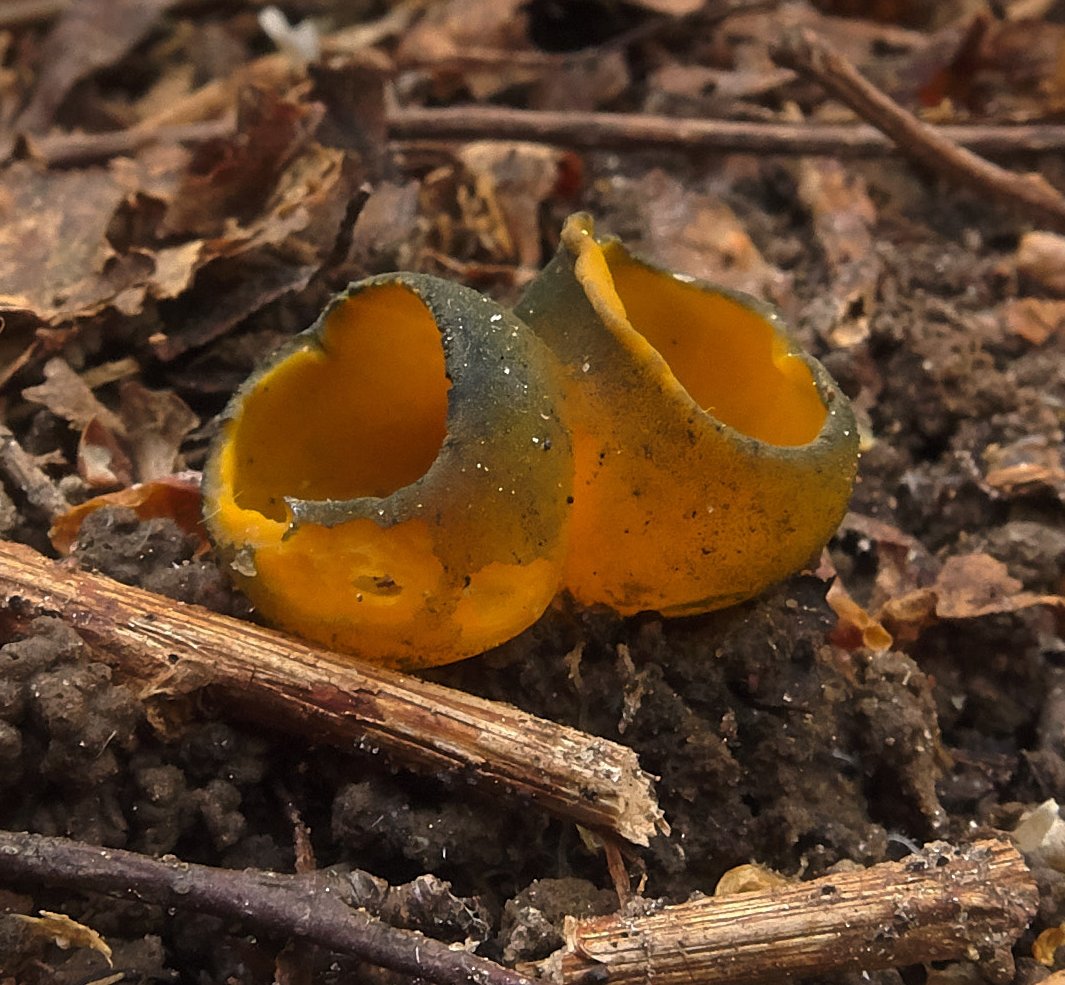
Caloscypha (lat.Caloscypha) is a genus of discomycete fungi belonging to the order Pezizales. Usually allocated to the Caloscyphaceae family. Type species - Caloscypha fulgens.
Description
Fruit body: 0.5 - 2.5 centimeters in diameter, less often up to 4 (5) cm. Egg-shaped in youth, then cupped with an inward-curved edge, later flatter, saucer-shaped. Often cracks unevenly and asymmetrically, then the shape resembles mushrooms of the genus Otidea.
Hymenium (internal spore-bearing surface) smooth, bright orange-yellow, sometimes spotted blue-green, especially in places of damage.
The outer surface is pale yellow or brownish with a distinct greenish tint, covered with the smallest whitish coating, smooth.

Stem: either absent or very short.

Flesh: pale yellow, up to 1 mm thick.
Spore powder: white, whitish Microscopy:
Asci are cylindrical, as a rule, with a rather truncated apex, without color change in Meltzer's reagent, 8-sided, 110-135 x 8-9 microns.
Ascospores are at first ordered by 2, but in adulthood by 1, spherical or nearly spherical, (5.5-) 6-6.5 (-7) microns; walls are smooth, slightly thickened (up to 0.5 microns), hyaline, pale yellow in Melzer's reagent.
Smell: does not differ.
Ecology
In coniferous and mixed with coniferous forests (Russian Wikipedia indicates deciduous ones; California Fungi - only in conifers) on the litter, on the soil among mosses, on coniferous litter, sometimes on buried rotten wood, singly or in small groups.
Season and distribution
Shiny Kaloscifa is an early spring mushroom that grows simultaneously with Microstoma, Sarcoscifa and spring stitches. Fruiting time in different regions is highly dependent on weather and temperature. April-May in the temperate zone.
Widely distributed in North America (USA, Canada), Europe.
Similar species
You can call Orange Aleuria (Aleuria aurantia), there really is an external resemblance, but Aleuria grows much later, from the second half of summer, in addition, it does not turn blue.
A number of sources indicate that the brilliant Kaloscif has some resemblance to Sarkoscifa (scarlet or Austrian), but identification difficulties can arise only for those who have never seen either Sarkoscifu or Kaloscifu: the color is completely different, and Sarkoscifa, as well as and Aleuria does not turn green.
Photo: Sergey, Marina.
Similar species
Young false pigs are incredibly similar to champignons. They are the same white with a domed rounded fleshy cap. They can be distinguished by their size, the mushrooms are still inferior in this aspect, as well as by the hymenophore - in mushrooms it is pinkish.
Adult pseudo-pigs become like giant talkers - mushrooms of the 4th food category, that is, conditionally edible. Talkers are also very large and their habitat is similar to wen. However, it is still possible to distinguish the "doubles". Talkers have a pronounced funnel-shaped cap of a cream shade. And the aromatic parameters of this mushroom are seriously inferior to wen.
The gentian white pig has a brown color, however, with age it becomes discolored and becomes similar to its "relative" - the row-shaped false pig. The main difference between these mushrooms is taste. The flesh of the gentian white pig is very bitter, for which this mushroom does not belong to the edible group.
Other names
White pig tricolor - (lat.) Leucopaxillustricolor
This mushroom is also found under other names:
- Leukopaxillustrech color;
- Clitocybe tricolor;
- Melanoleuca tricolor;
- Tricholoma tricolor.
Hat
White pig tricolor is considered one of the largest mushrooms. In mature specimens, the size of the cap can reach 35 cm. It itself is fleshy, often of irregular shape. Its surface is straight with shallow waves. The edge is slightly curved downward, wavy.
The color of the cap is not monochromatic, more often tricolor with a predominance of light brown, ocher and chestnut shades. The characteristic of this mushroom is the marbling effect, which is obtained due to the tightly pressed scales on the surface of the cap. They do not create a continuous coating, but seem to be broken by subtle gaps-grooves. These cracks are white, and the areas broken by them differ in shades, which creates the appearance of color inhomogeneity, tricolor.
Such modifications occur in the process of maturation and aging of tricolor snow pigs, because young mushrooms look somewhat different:
- The hat is of the correct shape, rounded;
- The edges are concave inward;
- The surface of the cap is dry, smooth, matte, felt
The hymenophore of this fungus is lamellar, yellowish or creamy in color. The plates themselves are not the same, densely planted, wide enough. Along the edge of the cap, short plates alternate with long ones attached to the leg. The junction forms a clear border.
The structure of the cap is soft, wadded. The pulp is watery, white in the cut and does not change color.
Leg
Relative to the cap, the leg of this species of white pigs is short, no more than 13 cm.Its thickness is not the same: from above it is narrow, no more than 4 cm, and closer to the mycelium it thickens up to 9 cm.The shape of the leg resembles a mace.
The stem color is usually white. Less commonly, it can be creamy yellowish in tone with the hymenophore. The surface is finely scaly, rough.
In the context, the pulp is white, dense and does not change color. The structure of the stem is solid, fibrous.
 White pig tricolor - (lat.) Leucopaxillustricolor
White pig tricolor - (lat.) Leucopaxillustricolor
Brush telephon (Thelephora penicillata)
Synonyms:
- Merisma cristatum var. penicillatum
- Merisma fimbriatum
- Thelephora cladoniiformis
- Thelephora cladoniaeformis
- Thelephora mollissima
- Thelephora spiculosa

Description
Fruit body: Short-lived small rosettes growing straight on the forest floor or on strongly rotted wood remains, not only on stumps, but also on fallen branches. An interesting feature: if the rosettes grow on the ground, they look rather "tortured", as if they were trampled, although in fact no one touched them. The sockets that have chosen rotten stumps for residence look much prettier.
Violet, violet-brownish, reddish-brown at the base, brownish in transition to the branched tips. The tips of the rosettes are highly branched, ending in pointed spines, creamy, creamy, white on the spines themselves.
Mycologists do not yet have a clear and unambiguous opinion whether the telephor is a brush fungus that forms only mycorrhiza with various living trees, or a saprophyte that feeds on dead and decaying wood debris, needles and leaves on forest soil.
Rosette dimensions: 4-15 centimeters across, individual spines 2 to 7 centimeters long.
Flesh: Soft, fibrous, brown.
Smell: does not differ, mushrooms smell of earth and dampness. There is a mention of a clearly distinguishable anchovy smell. Taste: soft, indistinguishable.
Spores: Angular ellipsoidal, 7-10 x 5-7 microns, with warts and bumps.
Spore powder: Purplish brown.
Season and distribution
In coniferous and deciduous forests, from July to November. It prefers to grow in moist acidic coniferous forests, sometimes it can be found in mossy areas, not only under conifers, but also under broadleaf trees. Distributed throughout mainland Europe, including Great Britain and Ireland, registered in Russia and North America.
Edibility
No data on toxicity. The mushroom is considered inedible: there is no taste, the pulp is thin, is not of culinary interest and does not cause a desire to experiment with the recipe.
Similar species
Terrestrial telephon (Thelephora terrestris) is much darker, most often found on dry sandy soils, especially with pines and less often under broad-leaved trees, also sometimes found with various eucalyptus trees.
Additional Information
Telephores are sometimes called "earth fans". In the UK, the Telephura tassel is protected not only as a rather rare species, but also because of its uneasy relationship with some species of orchids. Yes, in good old England, orchids are appreciated. Remember, "The Dog of the Baskervilles" - "It's too early to admire the beauty of the swamps, the orchids have not bloomed yet"? So, rare saprophytic orchids, including Epipogium aphyllum, Orchid Ghost and Coralorrhiza trifida, Oralid Coralroot parasitize on the mycorrhiza formed between trees and telephors. The ghost orchid, in particular, is much less common than, for example, Thelephora penicillata.
Photo: Alexander
Row-shaped false pig-Leucopaxillus lepistoides
Row-shaped pseudo-guinea - (lat.) Leucopaxillus lepistoides
This mushroom also has other botanical names:
- Pseudo-pig is lobular;
- Leukopaxillus is lepiform;
- The white pig is lepist-like.
- Leucopaxillus lepistoid;
The people call him nothing else but Zhirovik.
Hat
At a young age, these mushrooms are very similar to champignons - a spherical cap, white, dense and rather fleshy with edges curved inward. However, as they get older, the false pigs seem to bloom - the hat becomes flat, outstretched with a concave center.
This mushroom reaches a fairly large size - 30-40 cm in diameter.
The surface of the cap is dry, silky, smooth. The young have grayish scales. The edge is slightly fleecy. In adult specimens, the scales are already invisible, the edge of the cap becomes wavy. When wet, the skin becomes slightly sticky.
The color of the false pig is white or slightly grayish. It is not uncommon to see greenish or bluish spots on the surface. In old mushrooms, the central fossa begins to darken over time, becoming creamy, which is clearly noticeable in the contrast of the white color of the mushroom.
There is a lamellar hymenophore under the cap. The plates themselves are wide, often located and attached to the stem. In young animals, they are lighter, even white. With age, the plates darken slightly and acquire a creamy shade.
The flesh of the wen is white, elastic and dense, juicy enough, but when cut, the milky juice does not emit and does not darken. Has a pleasant aroma and rich mushroom taste.
Leg
The straight, one-piece cylindrical leg is rather fleshy, plump, 4 cm near the cap, and thickens towards the bottom, which gives it the appearance of a mace. Its color is white, the same as that of the hat. Pseudo-pigs do not grow much in length, 8 cm is the average size of the leg.
Its structure is fibrous, fleshy, dense. When cut, the pulp is white and does not change color.
Row-shaped false pig - (lat.) Leucopaxillus lepistoides
Description of the pseudo-pig
The color of this mushroom is light - the leg and cap are white. The size of the fruiting body is large enough, the mushroom looks quite powerful. The size of a fleshy cap can reach 25-40 centimeters. Dome-shaped hat.

The inner structure of the cap is fleecy. The color of the cap can be white or slightly grayish, while the center is brown. The surface of the cap is velvety. The edges of the cap are folded very deeply.
The leg is thick, its main feature is that it thickens closer to the rhizome. Its height is 8-12 centimeters, and its thickness is 4-6 centimeters. The color of the leg is white, sometimes with a gray-blue tint in the upper part. The plates are weakly avoiding or adherent. The color of the plates is white at first, then cream. The spore powder is also creamy. Spores are smooth, ellipsoidal.
Places of growth of the row-shaped pseudo-pig
Fats grow on the territory of Russia and the CIS countries. Row-like pseudo-pigs can be found in almost any place. They are often found in moist soil, in grass. These mushrooms bear fruit from mid-summer to autumn, before the first frost.

These are humus saprotrophs; they settle on fertile soils and grow in steppes and steppe forests. Wen settle in large rings, from one such ring you can collect a full basket of mushrooms.
In Russia, these mushrooms grow in the Krasnoyarsk, Stavropol Territories and in the Penza Region. In addition, pseudo-pigs are common in Southern and Central Europe.
Growing gentian flowers - heavenly flowers with a mountain character
Today I will talk about amazing colors that love height and cold. This is probably why their color is unusually bright and clear - absolutely blue, like the sky in the mountains.
Gentians among stones
I remember my first meeting with gentians. At the time of our student's youth, when we had an internship on Lake Baikal (I studied at the Irkutsk University at the Faculty of Biology), we organized a hike to the mountains to the Khamar-Daban ridge. The surroundings of Lake Baikal are full of the most extraordinary rare, endemic, almost exotic plants.
That picture still stands before my eyes: against the background of white snowfields, incomparably blue flowers - large glasses, growing as if immediately from the ground. These were large-flowered gentians. And a little further away, pink buds of badans, delicate white flowers of an alpine dryad and all around the thickets of kashkara - golden rhododendron, the bushes of which are completely covered with huge flowers of a lemon shade. Probably, it was from that time that I fell in love with the mountains.
Gentians and adonis. Photo by the author
And although later I had to visit the Altai Mountains a lot, it seems that I have never seen such beauty anywhere else. Maybe, of course, because these were my first mountains. I met different types of gentian in the foothill zone of Altai, I even tried to dig up and transfer them to the garden, but alas, they did not take root.
Chinese gentian decorated in all its glory
Botanical description
Gentians (Gentiana) belong to the family of the same name - Gentians. In their the genus includes about 400 species various grasses and semi-shrubs. The Russian name indicates the bitter taste of some parts of gentian, which is due to the content of glycosides in them. They received their Latin name thanks to the Illyrian king Gentius, in the II century. BC e., who treated a terrible disease plague with rhizomes of yellow gentian.
Gentian yellow
Gentians are of different heights: from miniature, growing no higher than 10 cm, to very tall (up to 150 cm). They have thick and short roots. On a straight stem, sessile, usually oval, slightly pointed, simple leaves are located oppositely. Flowers are often solitary, but they are also in inflorescences. They are distinguished by a funnel-shaped corolla with bent petals, as a rule, there are 5 of them, less often 4.
Gentians are often confused with bells.
Sometimes gentians are confused with bells because of their color and similar flower shape. Most often they have a bright blue or light blue color, but there are also purple, white, yellow. Different species bloom during the summer, some of them are spring and autumn flowering.
Most gentian species have medicinal properties. In folk medicine, remedies based on this plant used to treat various diseases of the gastrointestinal tract, gallbladder, liver. Gentian preparations help with diathesis, anemia, and in general, this herb is recognized as an ideal general tonic. Let's take a look at some of the most common types.
Pulmonary gentian
The pulmonary gentian (Gentiana pneumonanthe) has a wide distribution area: the entire territory of our country, the Baltic States and Scandinavia, as well as the Balkans and the Mediterranean, where it is found in meadows, forest edges and copses. The height of straight unbranched stems is from 25 to 60 cm. From below they are naked, only covered with tiny scales, above there are simple elongated leaves. Flowers of piercing blue colors about 5cm in diameter, are placed one at a time and bloom at the tips of the stems.
Pulmonary gentian. Photo from the site.
Seven-part gentian
In the European part of Russia, the gentian (Gentiana septemfida) grows. It grows in the Crimea, the Caucasus and Asia Minor. This short plant (about 30 cm) has many straight stems, all covered with narrow leaves.
Seven-part gentian. Photo from the site.
The flowers are dark blue, up to 4 cm, forming a capitate inflorescence. Flowering begins in mid-June and lasts until the end of summer. The plant is winter-hardy, used as an ornamental plant.
Gentian stemless
The stemless gentian (Gentiana acaulis) or the city of Koch (Gentiana kochiana) grows in the mountainous areas of Western Europe. The plant is up to 10 cm high. The stems are very short, the leaves are elongated, overwintering. Large glasses of blue flowers are directed straight up. There is a variety with white flowers. Flowering occurs in May-June.



